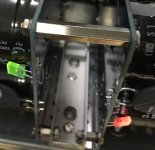it is irrelevant in series circuit
same as you have RC cell - it is cell
should you connect it as RC or CR........ they don't know and don't care
same as you have RC cell - it is cell
should you connect it as RC or CR........ they don't know and don't care
You‘re a naughty big mighty zm 😀
I knew that would blow you out of your sock, but a _*BLUE CAR*_ !!!
😀
:Cheers:
I knew that would blow you out of your sock, but a _*BLUE CAR*_ !!!
😀
:Cheers:
Hahaa ! HA! is working…
24.6Vdc / 24.9Vdc on both sides.
Nice dim led is gentely gloweling [emoji16]
View attachment 987798
Today was funny.
I was fumbling with the leds, and a tiny piece fell down near the rectifiers. Tried to catch it with a pinch and ZZZAP, a humongous spark flashed up, scared me into oscillation.
You know, after what, 36 hours unconnected theses beasts are still loaded? Gosh.
I wrote several times - I'm not using bleeders for caps (with time developed procedures without them**), but I don't have nothing against them..........
matter of safety
**when I'm not lazy , I put them on my T-Beds;in finished amps - never
matter of safety
**when I'm not lazy , I put them on my T-Beds;in finished amps - never
Ok, lesson learned.
1: good morning!
2: Big resistor good enough for a safe discharge? Or straight to a light-bulb?
(Since the psu hasn’t been connected to anything yet, I consider the caps will stay loaded for a very long time/until something drained them?)
Discharging will happen by connecting lightbulb/big-resistor to the psu‘s outputs? (+/gnd and -/gnd)?
Plus: to accomplish the level I guess I need to heatshrink the hard-wired rectifier-connectors (after they have been properly discharged)
(3🙂 Sorry to bother you with first-grader stuff and blue cars [emoji51]
1: good morning!
2: Big resistor good enough for a safe discharge? Or straight to a light-bulb?
(Since the psu hasn’t been connected to anything yet, I consider the caps will stay loaded for a very long time/until something drained them?)
Discharging will happen by connecting lightbulb/big-resistor to the psu‘s outputs? (+/gnd and -/gnd)?
Plus: to accomplish the level I guess I need to heatshrink the hard-wired rectifier-connectors (after they have been properly discharged)
(3🙂 Sorry to bother you with first-grader stuff and blue cars [emoji51]
since I have dummy load handy(8R, plethora watts) - I'm always using that to bleed caps, while working on amps
though - 8R I'm using usually when voltage is already sagged with circuit itself, so no sparks and big currents
when I'm dealing with voltages high enough to involve 1A and more , I'm always starting with 1K/3W or something as that, finishing with 8R
just matter of practice and routine
how to discharge - just observe it as connecting resistor across cap directly; where in circuit you are going to do that, matter of convenience
though - 8R I'm using usually when voltage is already sagged with circuit itself, so no sparks and big currents
when I'm dealing with voltages high enough to involve 1A and more , I'm always starting with 1K/3W or something as that, finishing with 8R
just matter of practice and routine
how to discharge - just observe it as connecting resistor across cap directly; where in circuit you are going to do that, matter of convenience
oh boy
damn greenhorns

spkr yes
psu yes
BCE for Ge Bigun ....... or BCE for 2SA1943 (or similar)
damn greenhorns

spkr yes
psu yes
BCE for Ge Bigun ....... or BCE for 2SA1943 (or similar)
Hello and thx from horngreen 🙂
It was the BCE that really bugged me, the other questions were put to fill the space


It was the BCE that really bugged me, the other questions were put to fill the space


it seems you're hanging these dayz with peppennino and andynor
it almost looks as 3 of you are having same agenda .......

it almost looks as 3 of you are having same agenda .......

- Home
- Amplifiers
- Pass Labs
- Old Soul



